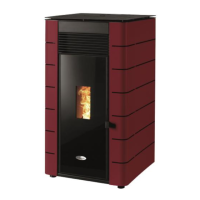11
materials. The base supporting the unit cannot be made of combustible material (e.g., carpet), so make sure you use an adequate
protection.
a) b)
Figure 9 - Minimum distances from all surfaces: a) upper view of the unit's installation; b) side view of the unit's installation
WARNING!
Keep combustible and flammable materials at a safe distance.
6.2. Installation of ducts and fume extraction systems
• The exhaust pipe must have been designed for this purpose, in compliance to the location requirements and in accordance with
any applicable regulations.
• Important! An inspection-T with an airtight lid must be attached to the exhaust pipe of the unit to allow the regular
inspection of the system or discharge of heavy dust and condensates.
• As indicated in Figure 9, the exhaust pipe must be assembled so as to allow cleaning and maintenance of the pipe by inserting
inspection points.
• In the K1700 model, if you want the flue to go up vertically behind the stove it is necessary to install a straight section of 25cm
(Figure 10) before the cleaning "T". This ensures a minimum distance to the protection box of the auger loading motor.
Figure 10 -
25 cm stainless steel tube
• Under normal operating conditions, the combustion gas flow should create a draught of 12 Pa one meter above the chimney
neck.
• The unit must not share the chimney with other equipment.
• Pipes outside the operating area must have double stainless-steel insulation and an internal diameter of 80 mm (K1200) or 100
mm (K1700 and K2300).
•
The fume exhaust pipe may generate condensation, so we recommend that the appropriate systems for collecting
condensates should be installed.
6.3. Installation without a chimney
The installation of the free-standing pellet fire without a chimney should be performed as illustrated in Figure 11, equipped with
an exhaust pipe (with a minimum diameter of 80 mm for the K1200 and 100 mm for the K1700 and K2300 model) directly
outside and terminate over the the roof level by at least 600mm. The termination should be in accordance with building regs to
avoid any high pressure zones.

